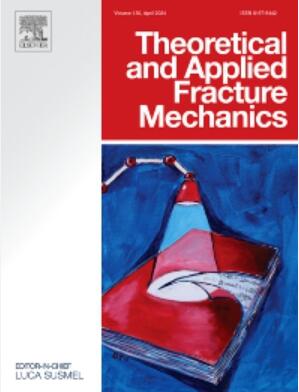Study on the dynamic mode I fracture characteristics of granite after different thermal-cold cycle
IF 5
2区 工程技术
Q1 ENGINEERING, MECHANICAL
引用次数: 0
Abstract
Geothermal reservoir rocks undergo cyclic thermo-mechanical loading during EGS operations, where progressive damage accumulation and fracture network development directly dictate system performance and longevity. In order to investigate the dynamic fracture characteristics of granite under the action of thermal-cold cycles, dynamic fracture tests are carried out on the central straight crack semi-circular disc (NSCB) granite specimens treated with multiple thermal-cold cycles (maximum number of cycles 13 times) at 400 °C, and the crack expansion rate is monitored. Based on the digital image correlation (DIC) method, the impact of thermal and cold cycling effect on the fracture process zone (FPZ) is studied, and the morphological characteristics of the fracture surface are analyzed. The effect of cyclic treatment on the microstructure of granite is investigated using scanning electron microscopy (SEM). The results show that the dynamic fracture properties of granite are significantly degraded under the action of repeated hot and cold cycles. When the number of hot and cold cycles reaches more than 10 times, the decrease is more than 28.7 %. The fracture process zone of granite begins to develop gradually from the crack tip. The length of the fracture process zone increases first and then decreases with the increase of load, and the maximum value is 9.2 mm. The dynamic fracture toughness, the maximum length of FPZ and the average crack growth rate decrease exponentially with the increase of the number of thermal cycles. The fracture surface fractal dimension is negatively correlated with dynamic fracture toughness, suggesting that the decrease of fracture resistance promotes the generation of rougher fracture surfaces. Macroscopic damage trajectories indicate that thermal cracking is the main factor controlling the theory expansion path. The combined effects of high-temperature heating damage, fast cooling, thermal-cold cycles, and water weakness are responsible for the deterioration of granite damage.
不同冷热循环后花岗岩动态ⅰ型断裂特征研究
地热储层岩石在EGS作业过程中经历了循环热机械载荷,其中渐进的损伤积累和裂缝网络的发育直接决定了系统的性能和寿命。为了研究冷热循环作用下花岗岩的动态断裂特征,在400℃条件下,对经过多次冷热循环(最多13次)处理的中心直裂纹半圆形圆盘(NSCB)花岗岩试件进行了动态断裂试验,并对裂纹扩展速率进行了监测。基于数字图像相关(DIC)方法,研究了冷热循环效应对断裂过程区(FPZ)的影响,分析了断口表面的形态特征。利用扫描电镜研究了循环处理对花岗岩显微结构的影响。结果表明:在反复冷热循环作用下,花岗岩的动态断裂性能显著退化;当冷热循环次数达到10次以上时,下降幅度大于28.7%。花岗岩的断裂过程带从裂纹尖端开始逐渐发育。断裂过程带长度随载荷的增加先增大后减小,最大值为9.2 mm;动态断裂韧性、FPZ最大长度和平均裂纹扩展速率随热循环次数的增加呈指数递减。断口表面分形维数与动态断裂韧性呈负相关,表明断裂阻力的降低促进了断口表面粗糙度的产生。宏观损伤轨迹表明,热裂是控制理论扩展路径的主要因素。高温加热损伤、快速冷却、冷热循环和水弱共同作用是花岗岩损伤恶化的主要原因。
本文章由计算机程序翻译,如有差异,请以英文原文为准。
求助全文
约1分钟内获得全文
求助全文
来源期刊

Theoretical and Applied Fracture Mechanics
工程技术-工程:机械
CiteScore
8.40
自引率
18.90%
发文量
435
审稿时长
37 days
期刊介绍:
Theoretical and Applied Fracture Mechanics'' aims & scopes have been re-designed to cover both the theoretical, applied, and numerical aspects associated with those cracking related phenomena taking place, at a micro-, meso-, and macroscopic level, in materials/components/structures of any kind.
The journal aims to cover the cracking/mechanical behaviour of materials/components/structures in those situations involving both time-independent and time-dependent system of external forces/moments (such as, for instance, quasi-static, impulsive, impact, blasting, creep, contact, and fatigue loading). Since, under the above circumstances, the mechanical behaviour of cracked materials/components/structures is also affected by the environmental conditions, the journal would consider also those theoretical/experimental research works investigating the effect of external variables such as, for instance, the effect of corrosive environments as well as of high/low-temperature.
 求助内容:
求助内容: 应助结果提醒方式:
应助结果提醒方式:


